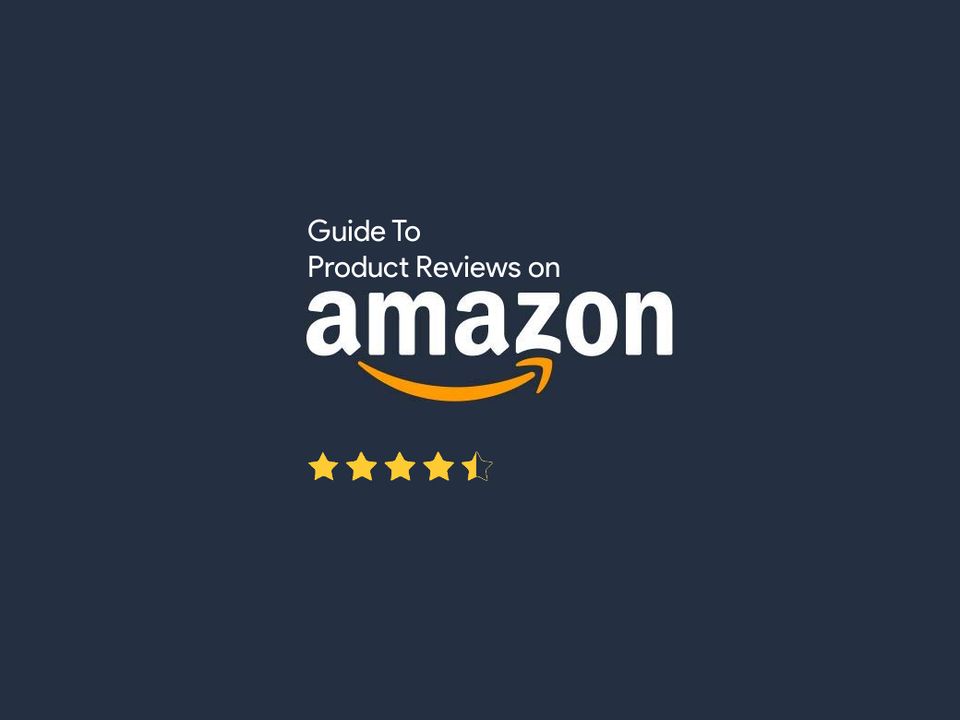The Ultimate Guide on How to Increase Your Product Review Rate on Amazon

It’s crucial for your business to apply a systematic approach to any aspect of your selling workflow (including potential threats which can harm your Amazon business).
With product reviews on Amazon becoming harder and harder to get, it’s important to put in place the framework which will help you maintain your competitive edge.
This guide will talk about the system you can apply to your business in regards to Amazon product reviews.
-
Specifically, the impact of a negative product review on your sales and how high it is -- which is proved it in this article.
-
Also, we present a framework on how to deal with bad product review on Amazon, so you don’t leave money on the table.
-
Additionally, we provide to you 1 actionable long-term strategy on overcoming negative reviews in the future.
-
The last but not least part of this article presents tactics on increasing the rate of positive product reviews that you can implement right away (according to Amazon ToS).
Let’s start.
Why do I need to deal with 1 star product reviews or 5 reasons why Amazon product reviews matter to merchants?
If your product doesn’t have a high overall rating (it has negative reviews) it will be less likely to appear high in the Amazon search results.
Let’s break it down.
If you take a look at first pages in Amazon search, for every product niche most sellers are at 4.5 stars, but the top sellers are often as high as 5 stars.
They get more views, better click through rates (CTR), better conversion rates and can often put higher prices too.
When you look at your business reports, specifically historical sessions and conversion data you could pinpoint certain dates where you had received bad reviews as dips in the sales curve.

Study after study has shown that consumers are increasingly reliant upon online reviews when making purchasing decisions. In fact, a recent Nielson study found that 70 percent of global consumers trust online reviews, up 15 percent within a four-year period. Industry experts project this trend to further increase in the coming years.
Doing business means constantly and systematically making improvements in all directions: customer communication, seller rating, product quality, shipping time, internal operations, etc. (try to automate this process as much as possible).
So you invested a lot of time and effort on your listing copy, packaging and follow ups to encourage people to leave reviews. Maybe even conducted a keyword research. Why not take the time to work on improving the reviews we already have?
How to change 1 star into 5 star review?
The best course of action is prevent buyers from posting negative review.
Here’re some steps you can use to prevent negative reviews:
- Add a packaging insert that says “If this item does not arrive in perfect condition or in 100% working order, then please reach out to us directly at https://www.amazon.[COM,CO.UK,DE,etc.]/ss/help/contact/?sellerID=YOUR_SELLER_ID for an immediate replacement”.
- Use “the WOW” moment when they leave you a positive seller feedback (use Bindwise tools for Amazon sellers to get notified about negative seller feedback), softly ask them for a product review.
- Improve your follow up emails to ensure customer with any problems contact you, not Amazon.
- Improve your packaging to avoid damage in transit.
But what if you received negative review? It takes a lot of effort to counter the impact of a negative 1 star review.
On average 13–17 positive 5 star reviews needed to counter a single 1 star review!
Hence, take care of the product reviews and don’t ignore negative reviews.
Converting your negative (1–2) and neutral (3–4) star reviews into 5 star is a quick way to increase your average review score, hence sales. Take a moment & think about that.
Do not hide from your mistakes. Most sellers, when hit with harsh feedback, will copy and paste a canned response. This is wrong!
For example, in its support center for businesses, Yelp offers a helpful document that warns, “contacting reviewers should be approached with care; internet messaging is a blunt tool and sometimes good intentions come across badly.”
We’d like to set the correct mindset. The goal is to quickly and wisely react to negative reviews and provide a level of service to the customer that persuades them to update their review to 5 stars. Though it’s impossible to control what upset customers may say, sellers’ reaction to the criticism have to be tempered.
Focus on solutions, not excuses. Set your ego aside and make amends by taking responsibility for a buyer’s poor experience, even if you aren’t truly at fault.
The steps you need to take depends on a type of review.
Identify a problem from a list below and jump directly to a sub-section to follow the steps to take:
👉 Item damaged/defective on arrival
👉 A review doesn’t comply with Amazon’s guidelines
👉 Customer isn’t happy with an item
👉 Customer thinks a product wasn’t worth the price
Item damaged/defective on arrival:
Step 1. Identify who left the review. Match the review to the customer's order.
Step 2. Now you know who left the review it’s time to read and re-read their review and really understand what went wrong for them.
Step 3. Offer a generous apology. Send a replacement item to the customer using expedited shipping.
Step 4. Send a card (buy them in advance) saying sorry, telling them about the replacement item and asking them to contact you by email for a full refund. Make sure you include the line like this:
I’d appreciate it if you could drop me a quick email to let me know that you’ve received this note and your replacement item too. PLEASE, reach out to us directly at https://www.amazon.[COM,CO.UK,DE,etc.]/ss/help/contact/?sellerID=YOUR_SELLER_ID
Leave it 7–9 days after shipping them the note and replacement, unless they reply before that.
Step 5. Reply and tell them how important 5 star reviews are to your “family” business.
I wanted to show you that as a small family run business we take all customer feedback seriously and that I am really sorry for your experience with our product. Can I just ask, was the replacement item I sent you an improvement on the first one your received?
Step 6. Engage a customer when they reply.
You may be surprised to know just how much a single negative review can affect our reputation, so I’m glad that it sounds like we may have improved your experience with us.
You need to be careful here. It’s against Amazon’s terms of service to ask a customer to remove or change a review.
YOUR ASSOCIATED COSTS: Cost of an item + extra FBM fulfilment + the refund + plus a card ($4).
A review doesn’t comply with Amazon’s guidelines:
Step 1. Identify who left the review. Match the review to the customer’s order.
Step 2. Now you know who left the review it’s time to read and re-read their review and really understand what went wrong for them.
Step 3. Identify an inappropriate product review on Amazon. Here’s some examples:
- one-word-reviews,
- spiteful remarks,
- advertisement, watermarks in videos or promotional material,
- several negative reviews for the same product from 1 customer,
- opinions of people of companies that have a commercial interest in reviewing their own or competitor products or have them reviewed by commissioned third parties,
- obscene or tasteless content,
- phone numbers, email addresses, URLs
- and more
Step 4. Request a removal of the review from Amazon. It is not very likely that Amazon will remove a review. Only if the review in question violates Amazon’s review guidelines in obvious ways, it might be deleted. Such a violation is only the case in extreme cases. The mere fact that a review is unfair is not enough to have it removed.
YOUR ASSOCIATED COSTS: $0.
Customer isn’t happy with an item:
Step 1. Identify who left the review. Match the review to the customer’s order.
Step 2. Now you know who left the review it’s time to read and re-read their review and really understand what went wrong for them.
Step 3. Send a card (buy them in advance) saying sorry, asking them to contact you by email for a full refund.
Step 4. When they reply they simply want to be heard and to be treated with dignity and respect. Therefore, invite them to help you build a better business. Have your clients contribute their ideas for how exactly you can improve your offerings so they may get the most value out of your product and so no one else will feel cheated the way they did.
Step 5. Do more than listen; deliver on any agreeable suggestions and keep all promises.
Step 6. Build rapport when/if they reply and tell them how important 5 star reviews are to your “family” business. Say that you hope that they have changed their opinion about their experience with your brand.
You need to be careful here. It’s against Amazon’s terms of service to ask a customer to remove or change a review.
YOUR ASSOCIATED COSTS: The refund + plus a card ($4) + promises.
Customer thinks a product wasn’t worth the price:
Step 1. Identify who left the review. Match the review to the customer’s order.
Step 2. Now you know who left the review it’s time to read and re-read their review and really understand what went wrong for them.
Step 3. Send a card (buy them in advance) saying sorry, asking them to contact you by email for a full refund.
Step 4. Build rapport when/if they reply and tell them how important 5 star reviews are to your small family business. Say that you hope that they have changed their opinion about their experience with your brand.
You need to be careful here. It’s against Amazon’s terms of service to ask a customer to remove or change a review.
YOUR ASSOCIATED COSTS: The refund + plus a card ($4).
A rule of thumb is to do something that they’re not expecting.
Now, imagine you’re a buyer. A few days after leaving a bad review you got a hand written sorry card in the mail from the owner of the brand. It addressed your issue fully and they took full responsibility for it. How would you feel?
Customers will feel surprised, in a good way, of course.
But remember don’t ask a customer to change or remove a review. It’s against Amazon’s ToS. However, it’s not against the ToS to deliver brilliant customer service, and in fact Amazon live by this mantra so they should be thanking you really.
In terms of the cost aspect, yes, changing review from 1 to 5 stars isn’t free, nor it’s a cheap option, but it’s 110% sure worth it to overturn a negative review. Cost per successful review change is approx. 2.5 times more of an item sale price (including cost of additional replacement, refund and a card). Additionally, you need to sell around 10 units to cover the cost of successful review change.
It’s also important to understand that you’re not going to win every case.
Long-term strategy on product reviews.

The section above showed you the way to change negative product review into a positive review, at the same time staying compliant with Amazon ToS.
But getting the customer to change their review is a short term goal. Let’s take a look what you need to do in the longer term to avoid bad reviews entirely.
Getting negative reviews is the beginning of something. And that something is nothing more than an opportunity to optimize your operations, product quality, delivery quality and more.
Think about it as an opportunity to avoid this exact same thing happening in the future.
Let’s break the strategy down.
Firstly, start recording negative reviews. Create a spreadsheet. Record the text of a feedback and put it into some category (product, delivery or any other issue). As time passes you’ll probably include more info. But start with the minimum information — it will be sufficient.
Having issues at a glance will enable you to categorise and prioritize.
Review the content bi-weekly. But don’t make decisions right away. You need to collect more data to put them in place. Meaning if during a couple of months you have 5–6 bad reviews about different issues, that doesn’t mean that you need to focus on changing your operations. Not yet.
But if you start to see common themes or problems that seem to occur more and more often then that is a sure sign that something needs improving.
Some common repeated problems could be solved by simple package re-design or an insert (do you put inserts in the package?), brochure or follow up emails.
Pro tip: if you receive 3+ negative reviews in a row saying the same thing and you still have many units in the stock before any new stock arrives, immediately address a known issue in your email sequence. Say something like,
A few customers have told us that they found it {address the issue} the first time they used it and that using {solution to the issue} help to the trick, so I thought I would pass that little tip on to you too.
The point is to address the known issue and tell them how to easily solve it without making a big deal of it. Make sense?— let me know in the comments section below.
Remember you don’t always need to make huge changes to your products to have a huge impact on the customer's experience with them.
How to increase your review rate on Amazon?

Have you thought about conversion rates for product reviews? The good one is about 3–5%, meaning that only that amount of clients who bought from you will leave you a review. Moreover, bad product/buying experience physiologically stimulates customers much stronger for posting a negative review than a good experience.
Without going deeply in psychology, this is explained by the fact that a buyer simply wants to be heard, thus desperately seeks for ways to spread a word about his own issues. Remember that.
So. It starts with a great product experience. When I say product experience, I mean overall buying experience.
There is so much rubbish out there. And you, as an e-commerce company, need to find a way to distinguish yourself from the masses, deliver value above average.
Let me give you an example. Imagine, you sell fancy bags. Your client ordered a bag and nothing more. They expect great experience, meaning they want the bag fast in a protected package without damages and of course a good quality product. They don’t know that you put in the package a black pompom, which cost you only $1, but is super trendy this season. Can you feel their “WOW” moment? What are the odds they will be willing to share their happiness in a form of a review? By the way, in this regard the western sellers should learn from the colleagues from the East — chinese sellers on AliExpress know the secret of doing a bit more than client expects, that’s why they always deliver some extra in their package.
The next step to drive more reviews is a call-to-action (CTA) package insert. Like, coupons, brochures, ebooks. But there is much more of it.
And it starts with a goal. In our case, the goal is to increase the rate of positive reviews. So take a pen and write down the steps — we’ll uncover below.
-
Start including prize based inserts. “Participate in our monthly contest and get a brand new Nike Air 7”. A SUPER important thing is to make the contest realistic enough that buyers feel they may have a chance of winning.
-
An insert should send a buyer to, e.g., Google Forms with a survey about a product they purchased. 1 question about the service, like, what was wrong during your experience with our store? or how can we do better? Buyers fill in the form, provide their name and email address and submit their responses.
-
On the “thank you page” of Google Forms simply tell them that you’re a growing brand and need their help. Ask directly that you want them to write a short product review on Amazon — then give them a direct link to make it easy.
-
Set an automated email repeating the content of the Step 3.
With minimum investments into a prize this framework will increase your product review rate, hence you’ll achieve the set goal from above.
In conclusion
By now, you should have a long to do list to ensure you’re optimizing your eCommerce business for product reviews.
As Amazon continues its path of ecommerce dominance, reviews will play an even more important role for third-party merchants. Understanding the psychology of customer reviews is important for making smart business decisions, winning the Buy Box and ultimately thriving online.
There is no reason to feel burdened with a sense of overwhelming guilt or shame that affects morale and performance.
Reviews are one aspect of your business that you can optimize. It’s not hard (but not free as well:), you just don’t need to be lazy and start thinking systematically regarding your business.
Product reviews in the customer journey should be a part of sellers’ long-term goal.





